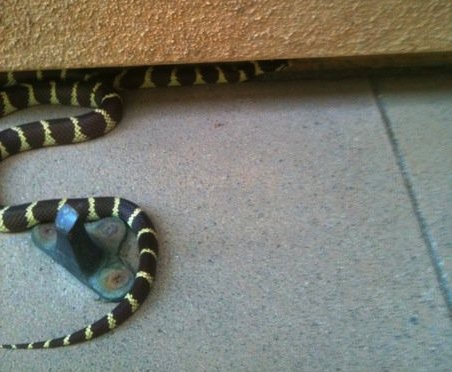
Spotted by Rosa Delgado at 5:16 pm today
After twelve years of searching, the good folks of Audubon Center at Debs Park finally spotted the elusive California King Snake today in the park.
Jeff Chapman, Director of the Audubon Center told LA Eastside:
“These guys have been seen in City Terrace, Ascot Hills, and Flat Top. I used to do reptile monitoring with kids from Franklin before the center and we never found them. Three years ago, we put out boards in the park and checked them periodically, but again we never detected them. So, this is very exciting for us and for the whole human/non-human community in the Northeast!”
If you live on the Eastside but have yet to visit the Audubon Center, now’s the time! There are all sorts of activities for children and adults and a very enjoyable trail from which you can take in the local floral and fauna of Debs Park.
Audubon Center at Debs Park
4700 North Griffin Ave. Los Angeles, CA 90031
(323) 221-2255
Hours: Tuesday – Saturday 9 a.m to 5 p.m.
The Audubon Center at Debs Park opened in 2003 as an environmental education and conservation center for the communities of northeast Los Angeles. The Center is located in the third largest park in the city of Los Angeles. More than half of the park is covered in walnut-oak woodland, grassland, and coastal sage scrub, a remnant of the native habitats that once rimmed the Los Angeles Basin. Over 140 species of birds have been recorded here.

Nice photo Chimatli, it’s too bad that the hills around the northeast and especially in Lincoln Hts and El Sereno couldn’t be somehow protected from further development. I can recall as a kid roaming around the hills and especially “Flattop”, almost always seeing king snakes, sparrow hawks, red tail hawks, rabbits, trap door spiders, those now rare white snails, coyotes, tarantulas, garden snakes, and the now almost never seen songbird “meadowlark” with it’s distinctive call. Once in Elysian Park near N. Broadway I saw a red fox.
And the grass’s, wild mustard (swiss chard), licorice (fennel), indian tobacco, wild onion, california poppy’s, lupine, seemed like thier used to be a lot more there in those hills.
Interesting note about wild mustard. It was brought by the Spaniards and father junipero serra left mustard seed up the El Camino Real to mark his trail so that he could find his way back.
However wild mustard is invasive and non-native, and categorized in California as a noxious weed. Because it was invasive, it crowded out native plants that ultimately were the life support to other native flora and fauna.
When I understood this, it changed my understanding of mustard. I once thought it beautiful, but now I see it as a botanical metaphor for displacement, genocide and colonialism. So when I see mustard now, I pull it out of the ground.
I just thought I’d share.
Manitou, thanks so much for the info on wild mustard. I had no idea! The cultural history of plants, wow!
DQ, I spent many an afternoon searching the hills for trap door spiders. They must be pretty good at hiding because I never found one! The last time I was up on Flat-Top it was covered with the castor bean plant. It’s an unfortunate introduction to the ecology of the area and the seeds are highly toxic/poisonous.
Lately, I’ve been doing a lot of gardening and have encountered one too many black widow spiders, eeek! 🙂